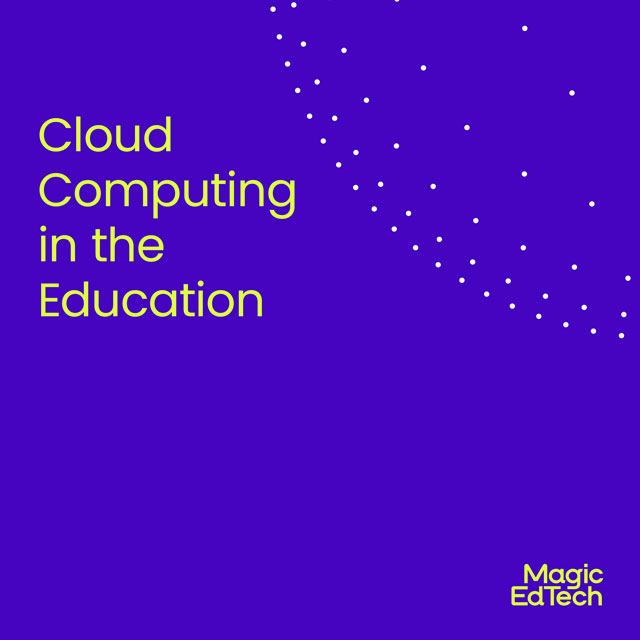Cloud Computing: Impact on EdTech
- 22 December, 2021
- Reading Time: 8 min
With the push for digital lesson plans and remote learning, IT systems – particularly cloud-based platforms have become more valuable than ever. Cloud is a potential technological creation that fosters opportunities for change for its users. Cloud computing is an information technology paradigm that provides computing delivery services like utilizing remote servers, database systems, networking, analytics, storage systems, software, and various other digital facilities through the Internet. Cloud computing offers significant advantages to higher education, especially from K-12 schools to university students. Using cloud technology in education, teachers can effortlessly impart online classes and join their students in various programs and online projects.
Cloud is by far the most widely used technology because of its flexible storage and usage mechanisms, robust security measures, and ease of use. Using the cloud, teachers can take online classes, store and share large files of different types and formats at the least possible cost. Thus, almost every EdTech company and educational organizations prefer to go with the cloud.
Impact of Cloud Computing on EdTech
Cloud Computing has evolved way beyond normal online data storerooms. It has given us the benefit of the decentralized sharing method. It is a convenient system that requires minimal human effort. Modern-day education needs to be driven by the latest technology that the twenty-first century demands. Incorporating digitization into the learning process mainly revolves around bringing education out from the classroom and delivering it to our home or workplace. Technology in education has come up to a new horizon making remote education and higher education more comfortable and online.
The impact of Cloud Technology in Education
Connectivity: Cloud computing allows EdTech companies and educational institutes to customize and share their inventory of files, apps, and media (online video classes and lessons) with ease. It brings comfortable connectivity of education to young minds. Cloud also impacts education by bringing together different forms of digital library of shared resources.
Better Collaboration: Real-time collaboration is a significant aspect of online and remote education. Cloud computing leverages this real-time support with different apps and API integration. Using cloud technology, teachers can create management portals and high-end processing power for remote learning with virtual classrooms. Apart from all these facilities, cloud management caters to a broad spectrum of collaborative opportunities making it easy to form an environment where students, teachers, and guardians can reside on the same page.
Bulk resource and recorded class: Video lecture creators, educators, and teachers can use cloud computing to index and store all the necessary materials like video-contents, notes, e-books, and other resources. Cloud technology is flexible enough to change with the number of resources stored. An online education platform or organizations providing online teaching can organize all the educational resources under one umbrella rather than giving a confusing garble of links.
Easy access and availability of resources: Cloud-based education also impacts the availability of resources and study materials. Cloud provides 24 x 7 availability of resources which improves physical and digital accessing also. A cloud system not only helps to access the resources but also lets students see the changes dynamically. Cloud follows the Web Content Accessibility Guidelines (WCAG) and security protocols to preserve the integrity of data.
Up-front cost reduction: Shifting to a cloud-based education system will impact saving users a notable amount of money. Managing the cloud using apps and integrating tools is also easy. That is why managing bulk resources does not require additional staff and technicians. Cloud computing also saves money on licenses, power, hardware requirement, and support.
Scalability: If you compare with on-premise resource management systems, cloud-based services are scalable with reduced cost and more efficiency. No matter how many students or participants you have, higher education facilities to manage, cloud systems can entertain without a glitch.
Built-in Analytics: Cloud services also come with analytics features that become helpful for adequate evaluation of student performance. Based on that, teachers can shift to adaptive teaching techniques. Analytics also helps in finding weaknesses in students effectively through visualization tools. It eventually reduces manual time and effort.
Eliminate Geo bounds: From the last decade, we have witnessed massive growth in eLearning platforms and online education systems. It is all because of the digital era where technology in education has a significant role to play. Students no longer have to worry about having a physical presence for the lectures in their classroom. They can use smartphones, tablets, PCs, or any other digital asset to attend classes. It eventually brings mobility to education.
Conclusion
Every organization and administration should weigh and heed attention to the impact cloud computing can bring on education. Cloud for EdTech means the organization has data mobility, more students from diverse geolocation, flexibility in cost and usage, and various other benefits. The future of digital education largely depends on the cloud.




